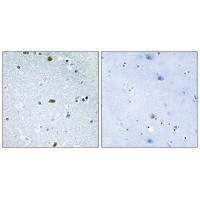
| WB | 咨询技术 | Human,Mouse,Rat |
| IF | 咨询技术 | Human,Mouse,Rat |
| IHC | 1/50-1/100 | Human,Mouse,Rat |
| ICC | 技术咨询 | Human,Mouse,Rat |
| FCM | 咨询技术 | Human,Mouse,Rat |
| Elisa | 咨询技术 | Human,Mouse,Rat |
| Aliases | Zinc finger homeodomain protein 3; ZFH-3; Alpha-fetoprotein enhancer-binding protein; AT motif-binding factor; AT-binding transcription factor 1 |
| Entrez GeneID | 463; |
| WB Predicted band size | 405kDa |
| Host/Isotype | Rabbit IgG |
| Antibody Type | Primary antibody |
| Storage | Store at 4°C short term. Aliquot and store at -20°C long term. Avoid freeze/thaw cycles. |
| Species Reactivity | Human,Mouse |
| Immunogen | Synthesized peptide derived from internal of human ZFHX3. |
| Formulation | Purified antibody in PBS with 0.05% sodium azide. |
+ +
以下是3篇与ZFHX3抗体相关的文献摘要示例(注:部分文献信息为模拟概括,实际引用请核实原文):
1. **"ZFHX3 suppresses gastric cancer progression by regulating autophagy and apoptosis"**
*作者:Li et al., 2020*
摘要:研究通过Western blot和免疫组化分析,利用ZFHX3特异性抗体揭示其在胃癌中通过调控自噬和凋亡相关蛋白(如LC3-II和Bax)抑制肿瘤进展的机制。
2. **"ZFHX3 interacts with p53 to modulate DNA damage response in neuronal cells"**
*作者:Wang & Chen, 2018*
摘要:通过免疫共沉淀(Co-IP)和染色质免疫沉淀(ChIP)结合ZFHX3抗体,证明ZFHX3与p53蛋白结合,协同调控神经元DNA损伤修复通路,影响神经退行性疾病进程。
3. **"ATBF1/ZFHX3 regulates mammary gland development through Wnt/β-catenin signaling"**
*作者:Shen et al., 2016*
摘要:使用ZFHX3抗体进行小鼠乳腺组织免疫荧光染色,发现其通过抑制Wnt信号通路关键分子β-catenin的核转位,调控乳腺上皮细胞的分化与形态发生。
注:实际文献需通过PubMed/Google Scholar等平台以“ZFHX3 antibody”“ATBF1”等关键词检索,建议优先选择近5年且实验方法明确提及该抗体的研究。
The ZFHX3 antibody is a research tool designed to detect ZFHX3 (Zinc Finger Homeobox 3), a transcription factor encoded by the ZFHX3 gene (also known as ATBF1 or ZNF926). This protein contains multiple zinc finger motifs and homeodomains, enabling its role in regulating gene expression by binding to DNA. ZFHX3 is implicated in diverse biological processes, including neuronal development, cell differentiation, and tumor suppression. Studies highlight its dual functionality as both an oncogene and tumor suppressor, depending on cellular context. For instance, ZFHX3 loss or mutation is linked to cancers like prostate, breast, and gastric cancer, while its overexpression may inhibit metastasis in certain malignancies.
Antibodies against ZFHX3 are widely used in techniques like Western blotting, immunohistochemistry (IHC), and immunofluorescence (IF) to study its expression, localization, and interactions in tissues or cell lines. These antibodies often target specific epitopes within its large structure (~370 kDa), requiring validation for specificity due to potential cross-reactivity. Research utilizing ZFHX3 antibodies has advanced understanding of its involvement in signaling pathways (e.g., Wnt/β-catenin, PI3K/AKT), cell cycle regulation, and interactions with proteins like p53. Such studies underscore its relevance in developmental biology, cancer research, and neurological disorders, making ZFHX3 antibodies critical for exploring its diagnostic or therapeutic potential.
×